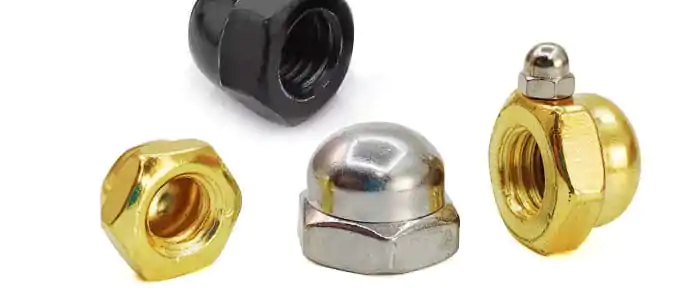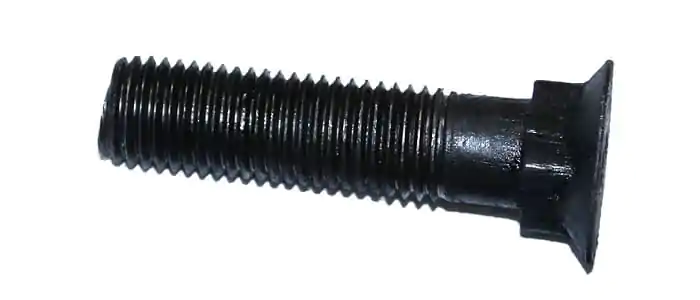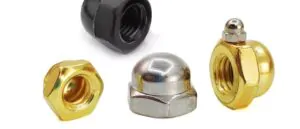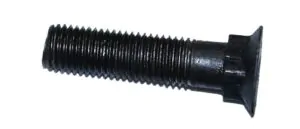Screw heads and drives come in a variety of styles, each offering its own unique benefits. Whether you need a flush finish, extra holding strength, tamper resistance, or improved load distribution, the right combination can make all the difference. Before diving into these crucial elements, let’s first go over the basic anatomy of a screw.
Basic Screw Anatomy
Understanding screw anatomy is key to choosing the right type for your project and ensuring effective use. Let’s break down the main parts of a screw:
Tip
The tip of a screw is designed to penetrate the material. It allows the screw to drill into surfaces, making installation easier.
Thread
Screw threads are the spiral ridges wrapping around the screw’s shaft. Threads engage with the material, creating friction that holds the screw in place.
Shaft
The shaft is the body of the screw connecting the head and the tip. It can be fully threaded or partially threaded, depending on the screw type.
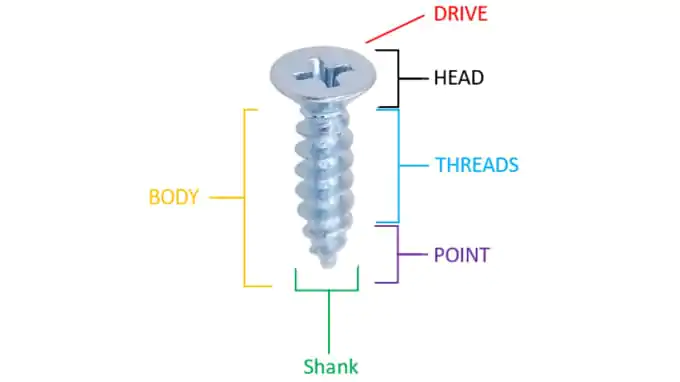
Head
The head is the top part of the screw that provides the surface for turning it into the material. Heads come in many shapes—flat, round, hexagonal, and more. The head’s shape determines the tool needed for installation (e.g., a screwdriver or wrench) and whether the screw will sit flush or above the material.
Drive
The drive is the area where the tool engages the screw to turn it. Different drives—such as Phillips, slotted, or hex—require specific tools and affect torque transmission. Some drives even minimize the risk of cam-out, where the tool slips out during tightening.
When selecting screws for your projects, pay special attention to the head and drive. These will have the most significant impact on your screw’s usability and performance.
Screw Head Types
Choosing the right screw head type depends on your specific application needs, including aesthetics, strength requirements, and material compatibility. Here are the most common screw head types:
1. Countersunk (Flat) Heads
A countersunk screw has a conical head that sits flush with the material’s surface. This type is ideal when you want a clean, smooth finish, with no part of the screw protruding. You’ll see countersunk screws in furniture, machinery, and even in some construction applications.
2. Non-Countersunk Heads
These include rounded or flat heads that rest on top of the material. They’re common when there’s no need to hide the screw, and visibility or a raised profile is acceptable. You’ll find them in woodworking, light construction, and even in decorative pieces where the screw itself adds a visual element.
Each screw head type has its own strengths, and the right one depends on how you want the screw to sit in your project. Countersunk heads provide a smooth, finished look, while non-countersunk screws offer ease of removal or add to the overall design.
Common Screw Head Types
Selecting the right screw head type is essential for ensuring the best performance in your project. Different head types offer varying advantages, such as a smoother finish, improved grip, or increased strength. Depending on your application—whether it’s construction, woodworking, or metalwork—the head type you choose can make a significant difference in both aesthetics and functionality. Below are some of the most common screw head types and their ideal uses:

Screw Head Types Table
| Name | Description | Uses |
|---|---|---|
| Flat Head Screw | A flat-top screw that sits flush with the surface. | Used where a smooth surface is required, such as furniture or woodworking. |
| Bingding Screw | A specialized screw for binding or securing two pieces of material. | Often used in bookbinding, packaging, and assembly kits. |
| Oval Head Screw | A flat head with a slightly domed top, allowing some head protrusion. | Used where a decorative finish is desired, such as in door handles or surface finishes. |
| Truss Screw | A screw with a large, rounded top that provides a wide bearing surface. | Used in light construction, metal framing, and electrical work. |
| Brazier Screw | A low-profile screw head with a wide bearing surface. | Commonly used in aviation and other mechanical applications. |
| Pan (jis) Screw | A screw with a rounded, low-profile head similar to a dome. | Suitable for light fixtures, electronic assemblies, and general-purpose use. |
| Pan (ansi) Screw | A screw with a slightly different pan head design, following ANSI standards. | Used in many general fastening applications, particularly in electronics. |
| Round Head Screw | A rounded dome-shaped head that protrudes from the surface. | Used in applications where the head needs to stick out for additional grip. |
| Button Head Screw | A cylindrical head that is lower in profile and easier to install. | Used in electronics and lightweight mechanical assemblies. |
| PF Screw | Special screw type for specific precision fastening applications. | Often used in industrial machinery where high accuracy is required. |
| CHEESE Screw | A screw with a cylindrical head and flat sides, like a cheese wheel. | Common in older electronics and mechanical assemblies. |
| Fillister Head Screw | A screw with a deep, rounded head and slightly elevated design. | Used for precise applications, often in machinery or electronics. |
| PAN WASHER Screw | A pan head screw paired with a washer to distribute load. | Suitable for general mechanical and industrial assembly requiring load distribution. |
| Indented Hexagon Washer Screw | A screw with an indented hexagonal head, typically used with washers. | Used in automotive and industrial applications for enhanced stability. |
Screw Drive Types
Different screw drive types serve distinct purposes based on torque application, tool compatibility, and ease of use. Here are some key considerations:
Torque Application
The main role of a screw drive is to allow torque (rotational force) to be applied to the screw. The drive type you choose can handle varying levels of torque, which is essential for secure fastening without damaging the screw or material.
Tool Compatibility
Each screw drive requires a specific tool. For instance, a Phillips drive needs a Phillips screwdriver, while a hex drive works with an Allen wrench. Tool compatibility ensures you have the right setup for efficient screw installation and removal.
Resistance to Cam-Out
Some drive types, like Torx and Robertson, are designed to reduce the risk of “cam-out,” which happens when the tool slips out of the screw head during tightening. These drives provide better grip and torque transmission.
Ease of Use
The design of the screw drive affects how easy it is to work with. Some drives offer quicker engagement and disengagement, making them more user-friendly in various applications.
Security Features
Certain drive types incorporate tamper-resistant designs. These are used in applications where security is a concern, such as public infrastructure or electronics.
Common Screw Drive Types
The type of screw drive you choose impacts not only the ease of installation but also the overall performance of the fastener. Different drive types are designed for specific tools, torque levels, and even resistance to slippage. Whether you’re working on a DIY project or handling heavy-duty machinery, selecting the right drive type ensures both efficiency and security. Here’s a look at some of the most common screw drive types and their best applications:

Screw Drive Types Table
| Name | Description | Uses |
|---|---|---|
| Raised Drive | A drive where the screw head is slightly raised above the surface. | Used in applications requiring some head protrusion for visual or structural reasons. |
| Flat Drive | A flat screw drive, where the head sits flush with the surface. | Common in woodworking, furniture, and applications where a smooth finish is needed. |
| Phillips (PHIPS) Drive | A cross-shaped drive that matches with a Phillips screwdriver. | Widely used in household appliances, electronics, and light-duty applications. |
| Flange Drive | A drive with a built-in flange that helps distribute load and reduce loosening. | Commonly used in automotive and heavy machinery for secure fastening. |
| Star (Torx) Drive | A six-point star-shaped drive. | Often used in electronics, automotive, and equipment where precision is needed. |
| Tri-Wing Drive | A three-winged screw drive often used for security purposes. | Used in electronics, aerospace, and devices to prevent tampering. |
| Square Recess Drive | A square-shaped recess that prevents slippage during tightening. | Common in woodworking and applications requiring a strong, secure hold. |
| Quadrex (QUADRE) Drive | A combination of Phillips and square drives for enhanced torque. | Used in high-torque applications like construction and machinery. |
| Sentinel Drive | A specialized security drive with a unique head design. | Used for high-security applications such as public infrastructure or devices. |
| Two-Hole Drive | A screw drive with two holes, often used for tamper-proofing. | Common in appliances and electronics to prevent unauthorized access. |
| Truss Drive | A large, rounded drive with a wide head that provides extra bearing surface. | Used in metal framing, electrical work, and lightweight construction. |
| Bugle Drive | A smooth, tapered drive with a large bearing surface, typically used with drywall. | Common in drywall installation for a flush, smooth finish. |
| Torx Pin Drive | A variant of the Torx drive with a central pin, used for additional security. | Used in electronics, automotive, and industrial applications for security purposes. |
| Pozidriv Drive | A cross-shaped drive similar to Phillips but with additional notches. | Used in European electronics and construction, designed for higher torque. |
| External Hex Drive | A hexagonal drive designed to be used with a wrench or socket. | Common in automotive, heavy machinery, and industrial applications for strong holds. |
| Pin Drive | A drive with a central pin, typically found in security screws. | Used in tamper-resistant applications, such as public fixtures and electronic devices. |
Conclusion
There you have it—a basic guide to screw head and drive types. Knowing which types to use for your project can save you time, money, and frustration. Whether you’re working on a DIY home improvement project or handling large-scale industrial jobs, understanding these screw components will help you make the best choices for your needs.
Need help finding the right screws for your project? Reach out to me at Hengrui Fasteners, and I’ll be happy to assist you in making the best decision.



